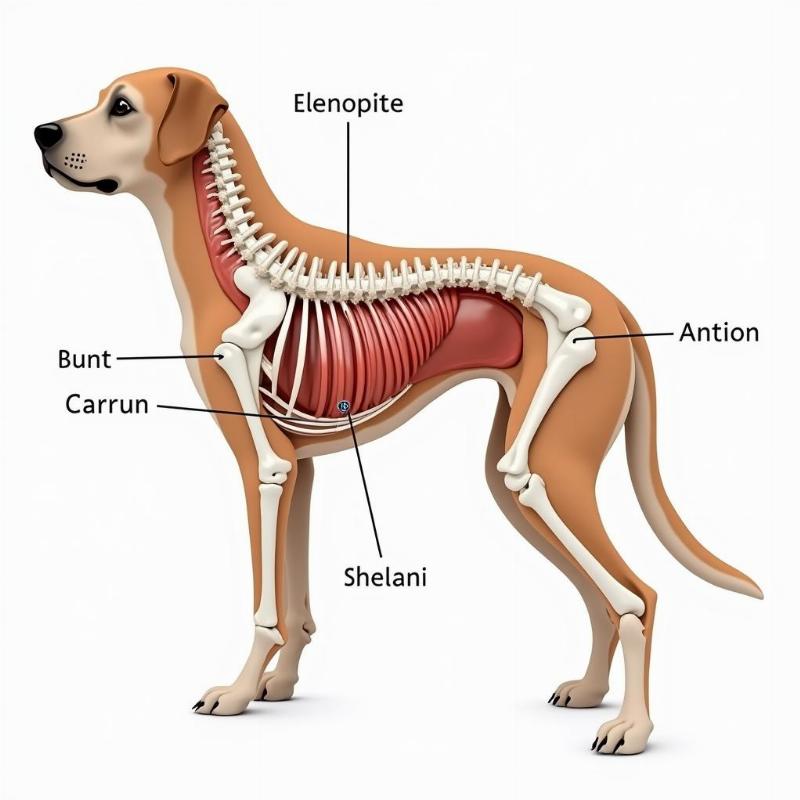A normal dog spine x-ray is a crucial tool for veterinarians in diagnosing a variety of conditions affecting a dog’s back. Understanding what a healthy spine looks like on an x-ray allows for early detection of potential problems such as intervertebral disc disease, arthritis, or even tumors. This knowledge can be invaluable for pet owners as well, enabling them to better understand their dog’s health and ask informed questions during veterinary visits.
Decoding a Healthy Canine Spine X-Ray
A normal dog spine x-ray will clearly show the individual vertebrae, the intervertebral discs that cushion them, and the surrounding soft tissues. The vertebrae should appear uniformly spaced and aligned, with no signs of fractures, dislocations, or bony growths. The intervertebral spaces should be consistent, indicating healthy discs. The surrounding soft tissues shouldn’t show any unusual swelling or masses. Veterinarians use specific measurements and angles to assess the alignment and health of the spine, comparing the x-ray to established standards for each breed.
Common Reasons for a Dog Spine X-Ray in the US
Several reasons might prompt a veterinarian in the US to recommend a spine x-ray for your dog. These can range from sudden onset of back pain or lameness to more chronic issues like difficulty walking or changes in posture. Trauma, such as a fall or car accident, is another common reason for spinal x-rays. Even seemingly minor symptoms like dog walking with a hunched back could warrant an x-ray to rule out underlying spinal problems.
Spotting Abnormalities: What to Look For
While interpreting x-rays requires professional training, understanding some common abnormalities can empower pet owners. Narrowed intervertebral spaces can suggest disc disease, while bony spurs or irregularities may indicate arthritis. Lytic lesions (areas of bone loss) or abnormal masses could be a sign of tumor on spine of dog. However, it’s crucial to remember that only a qualified veterinarian can definitively diagnose these conditions.
The Importance of Early Detection through X-Rays
Early detection of spinal problems through x-rays can significantly impact a dog’s prognosis. Early intervention allows for more treatment options, potentially minimizing long-term damage and improving the chances of a full recovery. Regular check-ups, particularly for breeds prone to spinal issues, are crucial. If your dog displays any signs of back pain or mobility issues, such as if your dog suddenly can’t stand up, consult your veterinarian immediately.
The Role of the American Kennel Club
The American Kennel Club (AKC) provides valuable resources on breed-specific health concerns, including spinal conditions prevalent in certain breeds. This information can guide breeders and owners in making informed decisions about health screening and preventative care.
 Dog Spine Anatomy Diagram
Dog Spine Anatomy Diagram
Conclusion
Understanding normal dog spine x-rays is essential for responsible pet ownership. By recognizing what a healthy spine looks like and knowing the reasons for x-rays, owners can be proactive in their dog’s healthcare. Early detection through x-rays can lead to timely interventions, improving the overall health and well-being of your canine companion. If you suspect a spinal issue in your dog, even something as seemingly innocuous as a x ray with dog in chest meme, don’t hesitate to consult your vet, especially if your my dog cant stand up.
FAQ
- How much does a dog spine x-ray cost in the US? The cost can vary depending on location and the complexity of the x-ray, but typically ranges from $150 to $400.
- Is sedation required for a dog spine x-ray? Sedation is often necessary to ensure the dog remains still during the procedure, resulting in clear images.
- How long does it take to get the results of a dog spine x-ray? Results are usually available within a day or two.
- Are there any risks associated with dog spine x-rays? The radiation exposure is minimal and considered safe.
- What are the alternatives to x-rays for diagnosing spinal problems in dogs? Other diagnostic tools include MRI and CT scans, which provide more detailed images.
- Can chiropractic care help with dog spinal issues? Chiropractic care can be a complementary therapy for certain spinal conditions, but should be done by a certified professional.
- What breeds are predisposed to spinal problems? Dachshunds, Bulldogs, and German Shepherds are among the breeds with higher incidences of certain spinal conditions.
Beautdogs.us is your premier online resource for comprehensive and reliable information on dog care, breeds, and products. We provide expert advice and resources for both new and experienced dog owners in the US, making us your trusted source for all things dog-related. Contact us today to learn more about how we can help you provide the best possible care for your beloved companion. Email: [email protected] Phone: +1 501-555-7529. Visit Beautdogs.us for more expert advice.